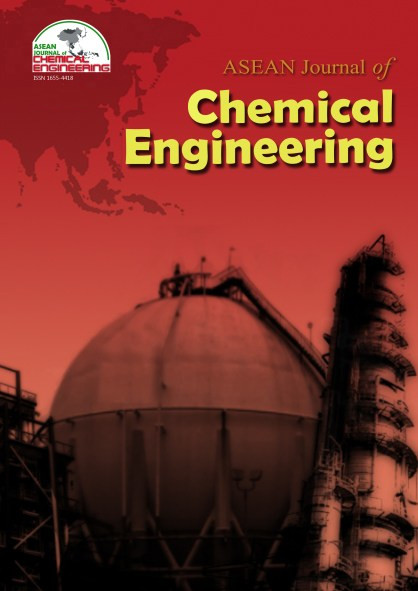Hydrolytic Process of Proteins in Moringa oleifera Seeds in Varied Concentrations of Sodium Hydroxide and Hydrochloric Acid
Abstract
Indonesia is endowed with an immense biodiversity that can be used as protein sources. One of these is Moringa oleifera tree that is locally known as Kelor. The seeds of this plant can be used as a protein source, an effective coagulant for water purification, a natural absorbent, and an antimicrobial treatment. Kelor seeds are known to contain fibers, proteins, carbohydrates, and vitamins. The objectives of this study were to identify the optimal solution concentration, determine the yield percentage, and determine the optimal protein content from hydrolytic processes of Moringa seed extraction using Sodium Hydroxide (NaOH) and Hydrochloric Acid (HCl). The hydrolysis took place for 30 minutes at 60oC. The proteins extracted from Moringa seeds were identified with biuret and Braford tests. The NaOH extractions resulted in the highest yield of 12.1% and protein content of 0.43% with 2% NaOH. Whereas those of HCl produced the highest yield of 11.1% and protein content of 9.63% with 1% HCl.
References
2. Anggraini, A. & Yunianta, (2015). “Pengaruh Suhu dan Lama Hidrolisis Enzim Papain Terhadap Sifat Kimia, Fisika dan Organoleptik Sari Edame”. Jurnal Pangan dan Agroindustri, 3, 1015-1025.
3. Bakhtra, D. D. A., Rusdi & Mardiah, A., (2016). “Penetapan Kadar Protein Dalam Telur Unggas Melalui Analisis Nitrogen Menggunakan Metode Kjeldahl”. Jurnal Farmasi Higea, 8(2), 143-150.
4. Bramantyo, A. E., Mustofa, A. & Syafril, I., (2014). “Pembuatan Bio Koagulan Dari Biji Kelor (Moringa oleifera) Sebagai Pengganti Koagulan Sintetis (Tawas)”, Surabaya: Institut Teknologi Sepuluh Nopember.
5. Gopalakrishnan, L., Doriya, K. & Kumar, D. S., (2016). “Moringa oleifera : A review on nutritive importance and its medical application”. Food Science and Human Wellness, 5, 49-56.
6. Gordon W.Selling; Mila P. Hojilla-Evangelista; Roque L. Evangelista; Terry Isbell; Neil Price; Kenneth M. Doll, (2013). “Extraction of proteins from pennycress seeds and press cake”. Industrial Crops and Products, 41, 113-119.
7. Idris, M. A., Jami, M. S., Hammed, A. M. & Jamal, P., (2016). “Moringa Oleifera Seed Extract : A Review on Its Environmental Applications”. International Journal of Applied Environmental Sciences, 11(6), 1469-1486.
8. Jubaidah, S., Nurhasnawati, H. & Wijaya, H., (2016). “Penetapan Kadar Protein Tempe Jagung (Zea mays L.) Dengan Kombinasi Kedelai (Glycine maz(L.)Merill) Secara Spektrofotometri Sinar Tampak”. Jurnal Ilmiyah Manuntung, 2(1), 111-119.
9. Krisnadi, A. D., (2015). “Kelor Super Nutrisi”. Blora: Pusat Informasi dan Pengembangan Tanaman Kelor Indonesia.
10. Kurniawan, Lestari, S. & R.J, S. H., (2012). “Hidrolisis Protein Tinta Cumi-Cumi (Loligo sp) Dengan Enzim Papain”. Fishtech, 1, 41-54.
11. Leone, A. et al., (2016). “Moringa oleifera Seeds and Oil : Characteristic and Uses for Human Health”. International Journal of Molecular Sciences, 17, 1-14.
12. M. Purwanto, M. G., (2014). “Perbandingan Analisa Kadar Protein Terlarut Berbagai Metode Spektroskopi UV-Visible”. Jurnal Ilmiyah Sains & Teknologi, 7, 1-71.
13. Mangale, S., Chonde, S., Jadhav, A. & Raut, P., (2012). « Study of Moringa oleifera (Drumstick) Seed as Natural Absorbent and Antimicrobial Agent for River Water Treatment”. Journal of Natural Product and Plant Resource, 2(1), 89-100.
14. Naga, W. S., Adiguna, B., Retnoningtyas, E. S., & Ayucitra, A. (2010). "Koagulasi Protein dari Ekstrak Biji Kecipir dengan Metode Pemanasan". Jurnal Widya Teknik.
15. Nofi, & Putra, A. N. (2013). “Pengambilan Isoleusin Dalam Konsentrat Protein Blondo Virgin Coconut Oil (VCO)”. Jawa Timur: Universitas Pembangunan Nasional "Veteran" Jawa Timur
16. Nurhayati, Mappiratu & Musafira, (2018). “Pembuatan Konsentrat Protein dari Biji Kelor (Moringa oleifera L.) dan Analisis Profil Asam Amino”. Kovalen Jurnal Riset Kimia, 4(1), 24-32.
17. Wijaya, A. I., Dewi, L., & Sastrodihardjo, S. (2013). “Perbandingan Kadar Protein Terlarut Pada Berbagai Macam Tempe Dengan Variasi Bahan dari Koro Pedang (Canavalia ensiformis L.DC) dan Kedelai (Glycine max (L) Merr)”. Seminar Nasional Kimia dan Pendidikan Kimia V, 302-308.
18. Sahay, S., Yadav, U. & Srinivasamurthy, S., (2017). “Potential of Moringa oleifera as a Functional Food Ingredient : A Review”. International Journal Food Science and Nutrition, 2(5), 31-37.
19. Salim, R. & Rahayu, I. S., (2017). “Analisis Kadar Protein Tempe Kemasan Plastik dan Daun Pisang“. Jurnal Akademi Farmasi Prayoga, 2(1), 19-25.
20. Sugiyono. (2004). “Kimia Pangan”. Yogyakarta: Universitas Negeri Yogyakarta
21. Sumardi. (1995). “Preparasi Contoh Untuk Analisis Asam Amino Dari Berbagai Bahan Berprotein”. JKTI, 5(1), 46-54.
22. Triyono, A. (2010). "Mempelajari Pengaruh Penambahan Beberapa Asam pada Proses Isolasi Protein terhadap Tepung Protein Isolat Kacang Hijau (Phaseolus radiatus L.)". In Seminar Rekayasa Kimia dan Proses.1-10
23. Witono, Y., Aulanni'am, Subagio, A. & Widjanarko, S. B., 2007. Karakteristik Hidrolisat Protein Kedelai Hasil Hidrolisis Menggunakan Protease Dari Tanaman Biduri (Calotropis gigantea). Berk.Penel. Hayati, pp. 7-13.
Copyright holder for articles is ASEAN Journal of Chemical Engineering. Articles published in ASEAN J. Chem. Eng. are distributed under a Creative Commons Attribution-NonCommercial 4.0 International (CC BY-NC 4.0) license.
Authors agree to transfer all copyright rights in and to the above work to the ASEAN Journal of Chemical Engineering Editorial Board so that the Editorial Board shall have the right to publish the work for non-profit use in any media or form. In return, authors retain: (1) all proprietary rights other than copyright; (2) re-use of all or part of the above paper in their other work; (3) right to reproduce or authorize others to reproduce the above paper for authors’ personal use or for company use if the source and the journal copyright notice is indicated, and if the reproduction is not made for the purpose of sale.



